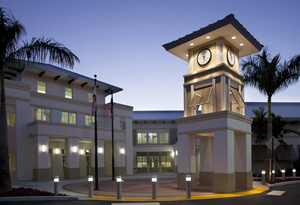A proposal to put six stories of residential units as small as 750 square feet each beside an 1,800-seat performing arts center near the Mall at Wellington Green ran into sharp questioning from the Wellington Village Council on Tuesday, May 9.
“We’re going to potentially put 480 residential units at the entrance to Wellington, and all this density,” Councilman Michael Drahos said. “I could never support this proposal under these conditions.”
Village officials had earlier granted 90 days for Project Lighthouse, which characterizes itself as a grassroots citizens group, to refine its vision for 10 acres that the village owns at 2175 Wellington Green Drive. The property behind the Hampton Inn northwest of the mall is also known as Wellington Green Park.
Next, the council will consider on May 30 whether to open the process back up with formal letters soliciting ideas from any interested companies.
The dense residential component followed initial pitches that focused on the arts center and office space, as more than 50 business tenants face losing offices at an aging complex beside Lake Wellington that the village owns.
The latest wrinkle, framed as a way to make the project work financially and provide more housing for area workers, met with skeptical reactions.
“When residents hear it’s 480 to 500 residential units of this size on that location, plus the office, plus the retail, plus the restaurants, plus the performing arts center, plus the parking garage… I’m not sure how that’s going to fly,” Councilman John McGovern said.
Project Lighthouse’s revised plan called for 40,000 square feet each of retail and office space in four-story buildings, along with six stories of residential units over one level of parking, sculpture gardens and the performing arts center.
The residential portion, 30 percent of which would be designated as workforce housing, “anchors the entire facility and helps fulfill the promise that this project will not fall on to the backs of Wellington taxpayers,” said Steven Traynor, a Wellington resident who leads the Project Lighthouse group.
Traynor introduced representatives of South Florida-based companies interested in helping to make the project happen: developer Blue Road, capital development firm BGI Companies, and architecture and planning company Song + Associates.
Blue Road is prepared to invest more than $100 million, Traynor said, and the project does not ask the village to underwrite bonds or do anything except what he called “a land grant.”
The residential, retail and office parts of the project could provide stabilizing income “if there happens to be any potential losses from the performing arts center,” he said. “There’s cash flow that can easily compensate for that. The idea that a few years down the road this project is going to fail is extremely low.”
Jorge Savloff, CEO of Blue Road, addressed questions about the size of the residential units. He said they would range from 750 to 1,200 square feet.
At one point, as many as 900 residential units came up in discussion, but developers scaled it back to a point where they think the plan still makes financial sense, he said.
“That’s the point where it becomes viable for this project to be financially sustainable,” Savloff said.
Drahos asked if anyone is planning for the impact of traffic from so many people and facilities at the site. Traffic studies would need to be done, Savloff said.
In answer to another question, Traynor said the project has been in touch with experts at running arts centers but does not have a contract in place at this stage.
“One of the things you said in your presentation is there would be no need to dispose of Wellington-owned lands,” Drahos said. “Well, of course, that’s what would be happening. You’re asking us to donate the land to you, basically, in a 99-year lease. So, we are disposing of Wellington lands if we were to approve this.”
Yes, but it would come with certain conditions, and land ownership is retained by the village, Traynor said.
Vice Mayor Michael Napoleone asked about the arts center, which would not be much smaller than competing venues in the region. He said the 2,200-seat Kravis Center in West Palm Beach operates with a budget in the tens of millions of dollars and at a deficit that is covered only through the aid of sponsors and donations. He questioned how for-profit operations in retail, office and residential spaces could meaningfully guarantee they would cover arts expenses.
“Where is the money coming from to operate a performing arts center?” Napoleone asked. “I’m not hearing that yet.”
Since the village would be giving a land grant, developers would incorporate some arts costs into their overall operating budgets, developer representatives said. More specific details would need to be worked out.
Wellington officials expressed a desire to hear more concrete particulars.
“I would be concerned how the revenues would be used to make sure the village is not holding the bag for the performing arts center, because I think everyone realizes it is going to be running at a loss,” said Village Attorney Laurie Cohen, who reviewed the proposal.
There could even be complications related to loans to build the project, if the land is used as collateral but the village technically owns it, she said.
Several council members said they did not understand why the village could not proceed with soliciting other competitive offers as Project Lighthouse hones its own proposal or submits a new one under a reopened call for ideas. If anything, the local group had a 90-day head start, McGovern said.
Traynor said it “takes the air out of the room” for a local organization that has tried to build support for the plan.








